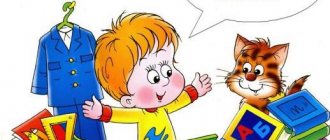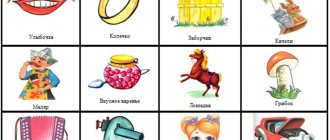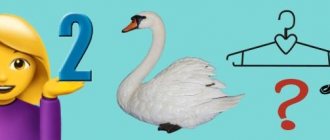Do you know how to explain vowel and consonant sounds and letters to your child? What about hard and soft? Take advantage of our tips, because before going to school, it won’t hurt your child to know how to characterize sounds; this will help him easily master the first grade curriculum.
shkolazhizni.ru
When starting training, you must be sure that the child has an idea of those organs of articulation that take part in the speech process (tongue, lips, teeth). Taking into account preschool age, it is easier to teach to distinguish between vowels and consonants sounds and letters in a playful way.
How to explain vowel and consonant sounds and letters to a child
“Some vowels and completely disagree with someone...” This sounds unusual for a child. To ensure your homeschooling is effective and stress-free, take your time. Catch the promised recommendations.
- The child must know the difference between a sound and a letter.
We hear and speak sounds, we see and write letters.
- Start by learning vowels.
They are much simpler in articulation and easier to perceive. It's simple: you can sing them.
The sound M is also quite worthy of a solo performance, but there is a difference: when pronouncing vowels, the air comes out freely, nothing interferes with it, the tongue lies calmly in the mouth, and with consonants it performs miracles of acrobatics.
- Reinforce spoken sounds with graphic images of letters.
Here your imagination can help you: you can write, sculpt, glue and lay out pasta or beans.
- Use a mirror.
Draw your baby's attention to the position of the mouth when pronouncing vowels, pay attention to the tongue and teeth.
- Together with your child, come up with words that begin with “singing” sounds, look for them not only in oral speech, but also in books, on the street and at home.
Where did O go? Here she is, disguised as a mirror. We found the letter and named the sound.
- Use riddles whose answers begin only with vowels.
- When starting to study consonant sounds and letters, note that there are many more of them and they are pronounced differently.
When we pronounce them, the air “clings” to an obstacle in the form of teeth or lips. In this case, the mirror is your obligatory assistant.
- Offer to “sing” consonant sounds, fixing the child’s attention on the position of the organs of articulation.
A restless tongue constantly interferes when trying to sing, and the teeth become completely capricious and close together.
LiveInternetLiveInternet
Quote from message Olia_Anatolevna
Read in full In your quotation book or community!
A game method for studying ten vowels in 5 lessons.
The method is based on the principle of repeated display and synchronous voicing of a group of symbols with their gradual partial replacement, proposed by the outstanding teacher Glen Doman. In this case, the task is made easier by the fact that in Russian the vowels form pairs that seem to rhyme: A - Z, O - Yo, U - Yu, Y - I, E - E.
1st game. "Wind". Explain to your child that the red letters are big brothers, and the blue letters are little brothers. Then say: “The wind came and mixed up all the brothers.” Mix the letters yourself so they don't end up upside down. Then let the child put them in order in pairs, calling them out loud: A - next to I, O - next to E (at first with your help). 2nd game. "Hide and seek." Cover the smaller cards with larger ones (red letters on top) and change the order of these pairs: “The little brothers hid under the big ones and swapped places so that Helen wouldn’t find them. Guess which little brother is hiding under big brother O? That's right, E is hiding under O! And under A? That's right, I am!” 3rd game. "Hide and seek." You play the same way, but this time it’s the other way around – the big brothers are hiding under the little ones. 4th game. "Crow". Move your palms over the cards laid out in the correct order and say: “The crow flew, flew, flew, flew and... ate the letter.” Quickly cover one of the letters with your palm: “Which letter did the crow eat?” It is better to move both palms at the same time, so that it is more difficult for the child to guess which letter you are going to cover. If he was unable to answer quickly, remove your palm for a moment and cover the letter again. If he doesn’t say it even then, tell him, for example: “Next to O. That’s right, E!” Over time, the child will remember the location of the letters and will guess them easily.
| Game "Crow". In the photo: the author is working with children. |
Game 5 "Cards". Now use the same cards to play with your child the same way adults play cards. You shuffle the cards, then throw a card on the table in front of him and ask: “What is this?” If you name it correctly - you win and take the card, if you make a mistake - another student takes it, and at home - your mother takes it. Don’t rush to allow other students to give you hints, let your child think a little. At first, try throwing cards in pairs: first O, followed by E, A - Z, etc. If the child wins confidently, throw in pairs, but in reverse order. Then start throwing randomly. The mother present at the lesson remembers and writes down how to play these five games at home. You only need to play once a day, unless the child asks for more. But each time, stop the game while he still wants to play: “We’ll finish the game another time.” Showing three pairs of vowels (A - Z, O - Yo, U - Yu). After you have played five games with the first two pairs of letters, take out the next pair of U-Y cards you made, write them on the back for yourself and add them to the pile (after the lesson, give this pile, all six letters, to your mother).
| A | I |
| ABOUT | Yo |
| U | YU |
Now show your child three pairs of letters the same way you showed him two pairs in lesson No. 1. Only this time the child names the first four letters, and you quickly name the last two yourself, not letting him make a mistake (remind your mother of this too). Give mom the same instructions as in lesson #1. By the next lesson, after two or three days of showing, the child will remember a new rhyme: “This is A.” "It's me". "It's about". "It is". "This is Y". “This is Yu.” Give your mom these six letters you made and ask her to bring them with her to the next lesson. Attention! After lesson No. 2, the mother shows the child these three pairs of vowels several times a day, but so far plays reinforcement games with him only for the first two pairs (A - Z, O - E) once a day. Lesson No. 3 By the beginning of this lesson, the children had already learned the rhyme: “This is A.” "It's me". "It's about". "It is". "This is Y". “This is Yu.” And thanks to five reinforcing games, the letters A, Z, O, E are also known randomly. Now they need to consolidate their knowledge of the last vowels they learned, U and Yu. Reinforcing games. Place the following six cards in pairs on the table in front of your child, calling them out loud, in the order in which they were shown to him. After this, play the games described in detail in lesson #2.
| A | I |
| ABOUT | Yo |
| U | YU |
Showing three pairs of vowels (O – Yo, U – Yu, Y – I). Put the first pair of cards A - Z somewhere away, take out the next pair you made Y - I, write the cards on the back for yourself and add them to the pile. Starting from this lesson, each time you add a new pair of vowels, you remove the first pair so that the total number of letters shown does not exceed six. Now the cards are in the pile in the following order:
| ABOUT | Yo |
| U | YU |
| Y | AND |
Show your child these three pairs of letters as you did in previous lessons. As before, the child names the first four letters, and you quickly name the last two yourself, not letting him make a mistake (remind your mother of this too). Give your mom all the letters you made and ask her to bring them with her to the next lesson. Tell your mom that all her homework will now take her no more than six minutes a day and remind her that it is important not to miss any of them. Attention! Pay attention to the mother that after this lesson, the child needs to be shown these three pairs of vowels several times a day, putting aside the well-known A - Z. And in the evening, you need to play reinforcement games with him once only for the first three pairs: A – Z, O – E, U – Yu (without Y – I for now). Lesson No. 4 By the beginning of the fourth lesson, children know the following vowels in pairs: A - Z, O - Yo, U - Yu, Y - I, and the letters A, Ya, O, Yo, U, Yu, thanks to reinforcing games, they also know scattered. Now they need to consolidate their knowledge of the last vowels they learned, Y and I. Reinforcing games. You have already realized that the number of vowels with which we play reinforcement games increases with each lesson: in the second lesson we played with four letters, in the third - with six, and now these five games need to be played with eight letters. Place the following eight cards in pairs on the table in front of your child, calling them out loud, in the order in which they were shown to him. After this, play the games described in detail in lesson #2.
| A | I |
| ABOUT | Yo |
| U | YU |
| Y | AND |
Showing three pairs of vowels (U - Yu, Y - I, E - E). This time you remove the first two pairs of cards A - Z and O - E, and take out the last pair you made E - E. Write these cards on the back for yourself and add them to the pile. The total number of letters shown is still six, and the rhyme remains just as easy to remember. It is also important that the letters E and E, which children often confuse, never “meet” when shown: when the letter E “came” in the fourth lesson, the letter E had already “left”. Now the cards are in the pile in the following order.
| U | YU |
| Y | AND |
| E | E |
Show your child these three pairs of letters as you did in previous lessons. As before, the child names the first four letters, and you quickly name E and E, which are new to him, without letting him make a mistake (once again, remind your mother about this). Give your mom all ten letters you made and ask her to bring them with her to class. Tell her that all her homework will now take her no more than six to seven minutes a day and remind her that it is important not to miss a single one. Attention! Pay attention to the mother that after this lesson, the child needs to be shown the last three pairs of vowels several times a day, setting aside the well-known A - Z and O - E. And in the evening, you need to play reinforcement games with him once for the first four pairs : A - Z, O - E, U - Yu, Y - I (without E - E for now). Lesson No. 5 By the beginning of the fifth lesson, children know all ten vowels; all that remains is to consolidate the knowledge of the last two vowels they learned, E and E. Reinforcement games. In this lesson, you need to play five games with all ten vowels. Place ten cards in pairs on the table in front of the child, calling them out loud, in the order in which they were shown to him. After this, play the games described in detail in lesson #2.
| A | I |
| ABOUT | Yo |
| U | YU |
| Y | AND |
| E | E |
Now you can give the child's mother all ten letters you made so that she continues to play reinforcement games with him once a day until the child begins to read. If the child loses interest in these games, you can leave only the last one - “Cards”. With the help of this game, it is necessary to ensure that the child recognizes each letter instantly. To do this, when showing the letters, you need to cover them with your palm, opening them only for a moment. This game does not take much time, it lasts no more than half a minute. Conclusion. If you strictly adhered to this lesson plan, then after lesson No. 5 your child knows all ten vowels the way you know them: he names them without thinking or making mistakes. It still happens that a child stumbles before naming a letter, and sometimes confuses two letters with each other. I noticed that this happens in two cases. Firstly, if the child has already been taught haphazardly before, and the mistake “stuck” in his head. Secondly, if parents are engaged in amateur activities, they “run ahead” and show their child at home those vowels that you have not yet taught in class. Remind parents that this should not be done, even if the child already knew some letters before. If, for some of these reasons, the child makes mistakes or names a letter uncertainly, just continue playing “Cards” with him for some time. At the same time, if a child does not remember a letter well, for example, E, throw this card in pairs with O: first O, followed by E. Then throw them in pairs, but in the reverse order, and only over time begin to throw randomly. But never try to help your child remember a letter by external signs or associations: “This is mother’s letter, and this is Yulina’s letter, this is E with dots, and this is E without dots.” This will completely confuse him: he will remember that one of them has dots, but will not know which one, and will try to guess. And he won’t be able to read something simple, like “favorite kitten.” After all, you will have to not only figure out “Yo with dots,” but also remember your friend Yulia, Aunt Ira and mother Olya. So, do not give in to the temptation to teach your child letters as quickly as possible, but with the help of this technique, lay in him a solid foundation of knowledge of vowels from the very beginning. Moreover, memorizing systematically shown letters in the form of rhymes of three lines does not require any effort from the child, and both children and parents enjoy reinforcing games.
Game method for studying consonants
You don't have to wait until your child has learned all the vowels to start learning the letters that represent consonants (for simplicity, I'll just call them "consonants"). The study of consonants can begin simultaneously with the study of vowels in the same five lessons. To begin, write down or print all 10 vowels that are still unknown to him in two columns of the table:
| To the left in red, | and on the right in blue |
| A | I |
| ABOUT | Yo |
| U | YU |
| Y | AND |
| E | E |
Tell your child that the large red letters are pretend big brothers and the smaller blue letters are pretend little brothers. Both of them love to sing songs. The big brothers (red letters) sing in scary voices because they are so big and pretend to be scary. Sing A, O, U, Y, E in a low voice, as the outstanding innovative teacher N. A. Zaitsev suggested in the original version of his methodology. Without wasting time on various “songs”, I chose the simplest melody corresponding to sol-fa-mi-re-do. And the little brothers (blue letters) sing with such little voices, because they are so small. Sing in a high voice Ya, Yo, Yu, I, E (the same melody sol-fa-mi-re-do, but one octave higher). As you sing, point out each letter with your finger. You can sing these two songs with your child several times a day after Lesson No. 1 until the child begins to sing them on his own. But under no circumstances should you ask the child where which letter is, because he has just started learning vowels with the help of the rhyme A-Z, O-Yi should not know them yet. Don’t ask him this even if he already knew some of the vowels before. These songs are not for learning vowels; children should just memorize them by ear for now. You may ask: “Why should we sing vowels, because we want to learn consonants, and we have already started teaching vowels in a different way?” Now you will understand everything. These songs are just a transitional stage to the next songs, with the help of which your child will learn consonants. For Lesson No. 2, prepare six tables similar to the one in Lesson No. 1. Only now the tables consist of six lines: consonants are placed in the top lines, hard ones are red and soft ones are blue, and in the remaining lines a consonant is assigned before each vowel, and these combinations form short open syllables, or warehouses. Tables can be written or printed on thick paper.
| B | B |
| BA | BY |
| BO | BYO |
| BOO | BYU |
| WOULD | BI |
| BE | BE |
| Vb | |
| VA | VYa |
| IN | WHAT |
| VU | VYU |
| YOU | IN AND |
| VE | BE |
| Gb | |
| GA | GY |
| GO | GYO |
| GU | GY |
| Gee | GI |
| GE | GE |
| YES | |
| YES | DY |
| BEFORE | DE |
| DU | DU |
| YES | DI |
| DE | DE |
| 3b | |
| BEHIND | ZY |
| ZO | ZY |
| memory | ZY |
| PS | ZI |
| ZE | WE |
| LH | |
| LA | LA |
| LO | LE |
| LU | Best Junior |
| LY | LI |
| LE | LE |
Now, together with your child, you first sing vowel songs, and after them, in the same way, songs in six tables: in low voices - the songs of the big red brothers and in high voices - the songs of the little blue brothers. Preface each song with a clear pronunciation of the consonants in the top lines. Teach your child to pronounce consonants with pure sounds, so that the vowels Y and I are not heard after the consonant sounds, and first of all, learn this yourself. Keep in mind that if a child gets used to saying Dy, Sy instead of the pure sounds D, S, then he will subsequently read lody ka instead of lodka, sy tul instead of s tul. If he pronounces the sound ББ as Bi, then when reading he himself will not be able to understand where is the dove and where is the dolu bi. And then it will take a long time to retrain him. Immediately show your child the letter b in the tables and tell him that it is called a “soft sign.” Remind him of its name from time to time. The letter Y is not included in these tables. Write it on a separate card, show it to the child and name it as it sounds (and the child will learn the name “And short” much later, when he reads books and learns the alphabet). Say that the words “yoghurt” and “yoghurt” begin with this sound. From time to time, remind your child about this letter by pronouncing it with a sound. The most difficult thing for both children and, at first, parents is to pronounce the pure sounds B, V, G, D; B, B, G, D. The rest are easier, especially the deaf. But Z and ZZ are quite simple. Ask the children: “Do you know how a big mosquito buzzes? Z-Z-Z. No, not Zy, but Z-Z-Z! The mosquito does not know how to say Zy, it does Z-Z-Z. How does a small mosquito buzz? ZZ-ZZ-ZZ. Komarik does not know how to say Z, he does Z-Z-Z. That’s what we call these letters: Z-Z-Z and ZZ-ZZ-Z.” Sing the words in these six tables with your child several times a day, and name the sounds in the top line yourself, without requiring it from the child. Usually, if the mother does not forget to do this regularly, by the third lesson the child already begins to independently and correctly name hard and soft consonants in some two tables out of six. In this case, just as when studying vowels, Glen Doman’s principle is used: after Lesson No. 3, these two tables are removed from the daily chant, and two new ones are added in their place.
| M | MY |
| MA | MY |
| MO | MIO |
| MU | Manchester United |
| WE | MI |
| ME | ME |
| NH | |
| ON | AE |
| BUT | NOT |
| WELL | Nude |
| WE | NI |
| NE | NOT |
In the future, such a replacement will occur every time the child remembers two new letters as a result of daily singing. Thus, every day, between lessons, the child will sing with you only six tables, no more, but the tables will be updated as the letters are memorized. And in order for the child not to forget the letters he has already learned, it will be enough for him to sing them independently only during lessons. Let me remind you that lessons are taught to the child twice a week by the teacher, but one of the parents can also act as a teacher, and in the intervals between lessons you repeat the content of the previous lesson with the child. After Lesson #4, you will remove two more tables and add two new ones.
| R | Pb |
| RA | RY |
| RO | RYO |
| RU | RU |
| RY | RI |
| RE | RE |
| Pb | |
| PA | PY |
| BY | PYO |
| PU | PY |
| PY | PI |
| PE | PE |
After Lesson No. 5, you will remove two more tables and add two more new ones.
| F | FH |
| F | FY |
| FO | FYO |
| UGH | FU |
| FY | FI |
| FE | FE |
| Kb | |
| CA | KY |
| KO | KYO |
| KU | KY |
| KY | CI |
| CE | KE |
After which you will have eight more letters left unlearned, i.e. four pairs of tables.
| T | TH |
| TA | TY |
| THAT | THOSE |
| THAT | TY |
| YOU | TI |
| TE | THOSE |
| S | |
| SA | SY |
| CO | SIO |
| SU | SJ |
| SY | SI |
| SE | SE |
| XH | |
| HA | HY |
| XO | HYO |
| XY | HY |
| XY | CI |
| HE | HE |
| LH | |
| JA | |
| JO | JO |
| ZHU | |
| ZHI | |
| SAME | |
| Sh | SH |
| SHA | |
| SHO | SHO |
| SHU | |
| SHI | |
| SHE | |
| HUH | |
| CHA | |
| CHO | WHAT |
| CHU | |
| CHI | |
| European Championship | |
| Shch | |
| SCHA | |
| SCHO | MORE |
| control room | |
| cabbage soup | |
| SHE | |
| CI | |
| CE | |
If you continue to teach your child two lessons a week, and sing six tables from lesson to lesson, replacing two tables each time, then you will need another two weeks to study these remaining eight letters. In total, you will spend from four to six weeks learning thirty-two letters of the Russian alphabet. I didn’t make a reservation: “thirty-two letters of the Russian alphabet.” You will introduce your child to the thirty-third letter Ъ later, when he has already read words in which this letter occurs, since, I repeat, any knowledge must immediately find its practical application, and he will not read words with the letter Ъ so soon. All I have to do is explain to you how to sing with your child some of the warehouses in the tables Zh, Sh, Ch, Shch, Ts. In nine rows of these tables, the warehouses are arranged in pairs. This is J-ZH, JO-ZHE, SH-SH, SHO-SH, CH-CH, CH-CH, SH-CH, SHCH-SH, TZ-CHI. In each of these pairs, the warehouses are written differently, but sound the same, therefore, when singing, these paired warehouses should be voiced with the same corresponding sound, pointing alternately to one and the other warehouse. One of my four-year-old students suggested: “They must be twins.” Since then, I also call them that for my children. The result of classes using this method is that the child masters in the shortest possible time and without noticeable effort all the letters of the Russian alphabet and acquires the skill of naming them with pure sounds. The child, in fact, did not have to make any effort. He just listened, repeated simple rhymes, played, sang songs. And as a result, I easily mastered what others spend months and even years on. And if anyone had to work hard for this, it was my mother. This simple technique is based on three pillars:
- on the principle of multiple display and synchronous sounding of a group of symbols with their gradual partial replacement, proposed by Glen Doman;
- on games developed by me that reinforce each stage of learning;
- on the singing of warehouse tables, proposed by another outstanding teacher N.A. Zaitsev. (It is extremely difficult to teach a child to pronounce a consonant with a clear sound, unless you sing or, in extreme cases, pronounce with him the words beginning with this consonant, since many consonants in their pure form are almost indistinguishable from each other by ear). In addition, singing these tables not only helps in learning letters, but also introduces the child to letters, and this is the first step to learning to read*.
*I outlined further steps in learning to read in my game method “Seven Steps to a Book.” In this technique, I no longer use tables, but my know-how, the so-called “houses for letters.” Author of the article: Sergey Polyakov Source
We strengthen the ability to distinguish between vowels and consonants sounds and letters
Once you have explained the difference between vowel and consonant sounds and letters, be sure to reinforce the skill you have developed. And play again.
- On the way from kindergarten, together with your child, come up with words that begin with a given sound.
- Draw a sheet of paper into squares, color them red and blue, and ask them to arrange the letters from the cut alphabet into “houses.”
- * Game “Attentive Ears”. The instructions are simple: “If a word begins with a vowel, clap, if a word begins with a consonant, stamp.”
- Come up with a recipe for an unusual dish, the ingredients in which begin only with certain sounds.
- When cleaning the apartment, give the task to first remove all toys that begin with consonants.
Important condition! Systematicity and calmness.
Your positive attitude will not only teach you to distinguish between vowels and consonants, sounds and letters, but also create a desire to learn.









